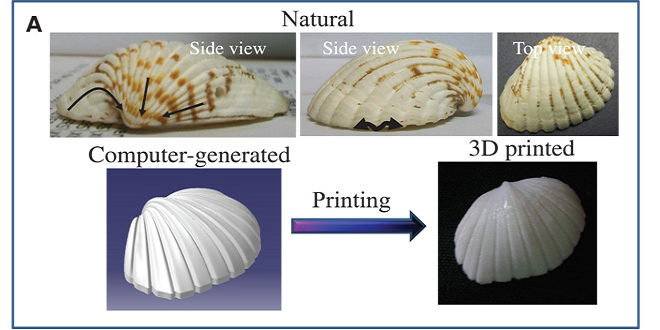
Our favorite shells are usually the ones that have come through the rolling waves unbroken. While fighting the elements on the way to arriving at the shoreline is a battle even the strongest shell often loses, engineering students at Rice University are interested in studying shells that offer significant evolutionary traits for survival due to their material. One shell in particular interests the team led by Chandra Sekhar Tiwary: your everyday mollusk.
Often not even a shell you might save at the beach, the mollusk exhibits extraordinary information that is quite interesting to Tiwary, a graduate student from the Indian Institute of Science and a visiting student at Rice. Tiwary brought some beachcombing finds from India into the lab, and began working to study the material qualities of this common shell – which is common for a reason. Its soft insides but durable outer shell are most easily able to withstand the assault of both predators and the elements.
“Nature keeps on making things that look beautiful, but we don’t really pay attention to why the shapes are what they are,” said Tiwary.
One of the strong points of the mollusk, literally, is the way it’s able to handle stress at certain areas, thus protecting a living creature, should it have a current inhabitant. It’s as simple as studying shape and function. The hard part for engineers is emulating the unique durability of something that’s had eons to evolve. With 3D software and 3D printing, however, researchers have more latitude in experimenting with designs and materials that could offer a better way to imitate nature.
“With the help of 3D printing, these ideas can be extended to a larger reality,” said Tiwary.
With digital analysis and 3D printed models, the team was able to look at shell nacre (perhaps better known as mother-of-pearl) from two vantage points, by inspecting two different types of mollusks:
- Bivalves, which would be best known as the clam shell, exhibiting two different exoskeleton components which are hinged.
- Terebridae, which exhibit the screw shape found in many popular shells one finds on the beach. Stress is managed at the hinge point, and then the mechanical load travels from the center to the top, thus explaining the function of the shell’s odd shape.
The findings were published in Science Advances, with co-authors Sharan Kishore, an undergraduate student; graduate student Suman Sarkar; and Professor Debiprasad Roy Mahapatra at the Indian Institute of Science.
Have you ever picked up a shell on the beach and considered the many facets involved in its shape, including mechanical load? Have you attempted to 3D print a shell design or similar structure or material? Share with us in the 3D Printing to Study Mechanical Load in Mollusks forum thread over at 3DPB.com.
